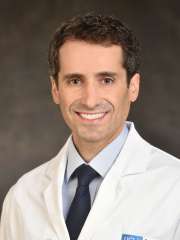Subarachnoid Hemorrhage
Find your care
Our expert team is skilled at treating complex cerebrovascular conditions and providing the finest and most comprehensive patient care. For help finding a neurosurgeon, call 310-825-5111.
What is a subarachnoid hemorrhage?
A subarachnoid hemorrhage (SAH) involves bleeding into the space between the surface of the brain (the pia mater) and the arachnoid, one of three coverings of the brain. A common cause of a subarachnoid hemorrhage is the sudden rupture of an aneurysm. A bleed from an arteriovenous malformation (AVM), head trauma or from certain types of hemorrhagic stroke can also be related to subarachnoid hemorrhage.
What are the symptoms of a subarachnoid hemorrhage?
Bleeding around the brain is a very serious condition that must be treated immediately. Symptoms may come on very suddenly and can include:
- Sudden severe headache (often described as "the worst headache of my life")
- Loss of consciousness
- Stiffness or pain in the neck or low back
- Nausea or vomiting
- Blurred or double vision
How is a subarachnoid hemorrhage diagnosed?
If you experience the symptoms of an SAH, our team of cerebrovascular specialists will use a variety of advanced imaging techniques to help determine the cause and location of the bleed. These tests may include:
- Computed tomography (CT) scan is used to examine brain tissue to locate and assess the subarachnoid hemorrhage.
- Lumbar puncture tests cerebrospinal fluid for blood.
- Cerebral angiography evaluates the blood vessels in the brain for causes of SAH.
How is a subarachnoid hemorrhage treated?
Once the cause of the subarachnoid hemorrhage is found, it needs to be treated immediately. If the SAH is caused by an aneurysm or AVM, the treatment will be one that is specific to those conditions.
Treatment of SAH generally occurs in three phases:
- Early intensive care focuses on supporting vital functions of the body, as well as preventing high blood pressure, additional bleeding or seizures.
- Surgery (open or endovascular) to prevent additional bleeding.
- Late intensive care to monitor, prevent and treat conditions caused by the SAH, such as seizures, hydrocephalus (increased fluid in the brain) and vasospasm (a constriction of the blood vessel).
Contact us
To schedule an appointment at the UCLA Cerebrovascular Program, please call 310-825-5111 or request a call back for an appointment.

Geoffrey Colby, MD, PhD

Jeremiah Johnson, MD
